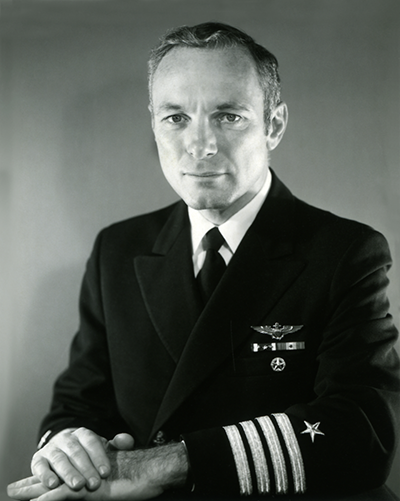
Capt. Leonard Anthony (“Tony”) Bracken Jr. (1933–2018) was a U.S. naval aviator who also served two tours at the U.S. Embassy in Moscow and had a second career as a successful business executive.

A native of Philadelphia, he was the son of Anna Rose Collins (Oct. 29, 1904–Nov. 10, 1949) and Leonard Anthony Bracken (Dec. 25, 1900–Dec. 3, 1961). Tony attended Chestnut Hill Academy (1948), William Penn Charter School (1951) and the U.S. Naval Academy in the class of 1955, where he lettered as manager of the wrestling team.
After graduating college, Bracken attended flight school in Pensacola, learning to fly on North American Aviation T-6 Texan aircraft. He earned his “wings,” becoming a naval aviator, in November 1956.
His first assignment was in Iceland as a long-range patrol pilot, flying the Lockheed P2V-5 Neptune to numerous destinations in Europe with Patrol Squadron 16, known as VP-16, which was based in Jacksonville. He entered the “Realm of the Arctic Circle“ just after officially becoming a lieutenant (junior grade) while piloting a P2V Neptune in December 1956. His second deployment with the VP-16 squadron was to Morocco and Spain.
He transitioned to carrier-based aviation on his second assignment with Fleet Air Support Squadron 3 (FASRON 3), based out of Norfolk, flying Grumman C-1 Traders to carriers in the Atlantic Ocean, delivering mail and cargo, as well as transporting personnel.
Bracken married Martha Ella Dobarzynski of Jacksonville in May of 1959.
As part of a USS Wasp (CV-18) “mercy mission“ to the waters off the Congo, starting off for the South Atlantic in mid-July 1960, Bracken was the first to fly into the strife-torn, newly independent country. He was chosen for his role to fly in and establish a liaison because of his French language skills.
Upon his request, Bracken was transferred to Naval Intelligence School in Washington, D.C., where he would also become a qualified Russian language interpreter and translator. The Brackens had a son in early 1961.
Lieutenant Bracken was the assistant U.S. naval attaché in Moscow from 1962 to 1964. During this time, his work drew the ire of the Soviet government. Accusations of improper behavior involving observation of Russian military programs resulted in tit-for-tat travel restrictions of U.S. and Russian diplomats in Moscow and Washington.
Some of these incidents were the subject of articles in the New York Times and other newspapers. The Associated Press photographed Bracken in an overcoat and fedora at the Copenhagen airport and labeled him “an American spy” while erroneously reporting that he had been declared persona non grata.
Returning to aviation, Bracken specialized in airborne anti-submarine warfare, flying Grumman S-2 Trackers with various squadrons on carriers deployed in the Caribbean, Mediterranean and Baltic seas.
Bracken was then dispatched to Athens where he headed the U.S. anti-submarine training detachment to Greece on a six-month assignment from September 1969 to March 1970.
Once again stateside he became first the executive officer and then the commanding officer of Air Anti-Submarine Squadron 31 (VS-31) stationed at Quonset Point, R.I., and undertaking missions on the U.S.S. Intrepid. In March 1973, Reader’s Digest reported from the U.S.S. Intrepid on a patrol mission during which Bracken successfully located a Russian submarine.
Subsequently, while commander of the Coronado-based Carrier Anti-Submarine Air Reserve Group 80, which comprised six squadrons, he officially earned his commander stripe and also became a helicopter pilot.
Bracken completed programs at the Defense Intelligence School and the National War College in Washington, D.C., while simultaneously earning a master of science degree in international relations from George Washington University in 1976.
After additional Russian language training, Bracken was reassigned to the Moscow embassy as naval attaché, where he served from June 1977 to June 1979. He played a key role in the Soviet rescue of a U.S. military aircraft that crashed in the Bering Sea in October 1978 off the Kamchatka Peninsula. Bypassing normal protocols, Bracken communicated the need for emergency assistance directly to the Russian chief of naval operations, thus saving precious time. Ten U.S. airmen were rescued by a Soviet fishing trawler after 12 hours in the freezing water.
For his service on this tour, he was awarded the Defense Superior Service Medal.
“By virtue of frequent travel and keen powers of observation he dramatically enhanced the accumulation of high priority information about many aspects of the enigmatic Soviet society,” the text accompanying the award said. “More specifically, his knowledge of the Soviet Navy enabled him to interpret major new Soviet initiatives in this area.”
Bracken went on to head the Nuclear Negotiations Branch of the Office of the Chief of Naval Operations from August 1979 to May 1980, and he was awarded the Legion of Merit Medal for his “unique insight into Soviet motivations” as the principal Navy advisor on several nuclear arms negotiations.
“His superior intellect and clarity of expression contributed significantly to the mission of the Strategic and Theater Nuclear Warfare Division during a period encompassing international events of historic importance,” the text accompanying the medal said.
Bracken also received the Navy Commendation Medal (or gold stars) for his service as:
Tony retired from the Navy in June 1980 and pursued a career as a business executive with a focus on international sales of oceanographic research devices with Sippican, Inc. He retired in 1995 as the vice president of marketing.
A lifelong golfer, Bracken was a member of the executive committee of the Washington Metropolitan Golf Association from 1997 to 2005, where he served as treasurer. He also officiated and conducted tournaments for the U.S. Golf Association in the DC area.
During this time, Bracken wrote a book, Lake Barcroft History (2001), for which he received a distinguished service award from the Fairfax County Historical Society in 2014. Tony also served as one of three state-appointed trustees for the Lake Barcroft Watershed Improvement District from 2001 to 2008.